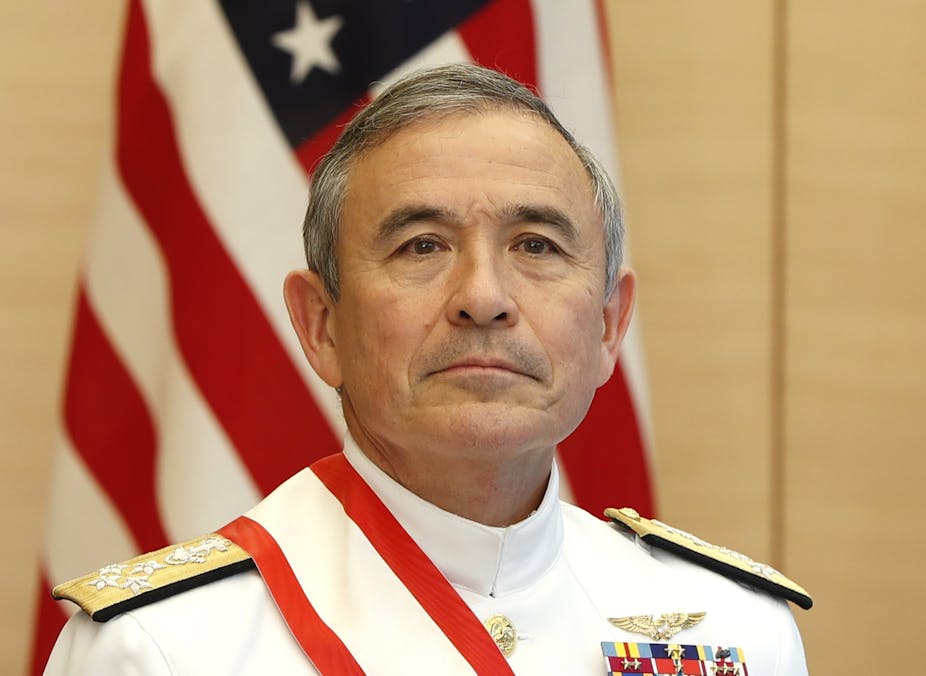Last week’s sudden announcement that the man assigned as the next United States ambassador to Australia will instead be posted to South Korea has generated concern among some commentators.
US President Donald Trump nominated Admiral Harry Harris as ambassador to Canberra in February. Former ambassador John Berry left his post in September 2016, meaning it has been vacant for 19 months.
Read more: As a new defence chief comes in, Australia must focus its attention on its neighbours
Former deputy prime minister Tim Fischer has described the delay in appointing a new ambassador as an “insult and with impact”, while former prime minister Kevin Rudd has claimed that “Australia, from President Trump’s perspective, is a second-class ally”.
Prime Minister Malcolm Turnbull, though, has said he can “well understand” the decision to reallocate Harris to South Korea, given the admiral’s expertise.
There is no need for overreaction, because US-Australia relations are in safe hands. Chargé d'affaires – the official in charge of a diplomatic mission when the ambassador is absent or the position is vacant – James Carouso is the acting ambassador, pending another appointment.
What does an ambassador do?
The role of an ambassador is to represent the interests of a country. They are the highest-ranking representative of a state in the country or international organisation to which they have been appointed. In addition to representing the state at negotiations, state dinners, and events, the ambassador also manages the embassy staff.
Ambassadors are the heads of embassies. Their duties include protecting and defending the reputation and image of their country, assessing the effectiveness of its policies in the host state, reporting information, protecting the welfare of citizens, and promoting cooperation across business, education, science, technology, culture, and national security domains.
Specific to the United States, the ambassador’s role also involves coordination of the various agencies (for instance, coordinating between the departments of defence, commerce and treasury on sanctions) that may be represented in a given country, because the US typically has a larger footprint than other countries. The president appoints the US ambassador, who reports to the secretary of state.
Given the functional requirements of the position, ambassadors might be expected to possess serious foreign policy expertise and experience. However, this is not always the case.
Read more: How do you become an ambassador?
Over the years, the US and other countries have appointed businessmen, ex-politicians, fundraisers and other people from outside the diplomatic establishment to ambassadorial positions.
Arguably, such appointments reflect the diminished role of ambassadors. The reality is that modern foreign policy work actually happens at home – in the external affairs departments of governments. In the US, foreign policy is the domain of the Department of State, which is typically headed by a powerful secretary of state. Ex-CIA director Mike Pompeo was confirmed as the new secretary of state on April 26 after Trump fired Rex Tillerson.
Why the vacancy is not an insult
The Trump administration has recently been preoccupied by a number of high-profile problems with executive appointments and resignations. The withdrawal of Trump’s nominee to lead Veterans Affairs is just one illustration.
On the ambassadorial front, the Trump administration has been particularly slow. Of the 186 ambassadorial positions in global capitals, 62 are vacant. About 17 of these are because the Senate has not yet confirmed the president’s nominee.
Another reason for delays in ambassadorial appointments may be budget cuts imposed on the State Department. These cuts have led former senior diplomats to accuse the administration of gutting America’s diplomatic capabilities.
Moving Admiral Harris to Seoul is not an insult or reflection of Australia’s “second-class” status. It can be explained by the simple reality of the heightened diplomatic activity in the Korean Peninsula.
In fact, Harris’ appointment in the first place belies criticism that the US treats Australia as “second class”. Harris was previously commander of the US Pacific forces and was appointed because of his strong record on China – indicating the importance of Australia in US strategy for the region.
Trump’s sudden announcement of a summit with North Korean leader Kim Jong-un after a prolonged period of exchanging insults and escalating threat of war caught the foreign policy establishment by surprise. Harris’ changed appointment merely reflects the need for a diplomat with strong military experience in a high-risk arena.
Read more: Five assumptions we make about North Korea – and why they're wrong
Equally, the transfer is a luxury afforded by the strong relationship between Australia and the US, where an urgent appointment may not be necessary. US-Australia relations have been resilient even without an ambassador in place.
To recollect, Trump’s now infamous phone call with Turnbull did not adversely affect the relationship, as evidenced by the warmth both sides exhibited during Turnbull’s visit to the White House in February.
Aside from the friendship at the highest level, ministerial and other contacts have sufficed to ensure cooperation on bilateral and multilateral matters.
At the same time, a quick appointment would be desirable. Australia is a close ally with a stable relationship, but sits in a region with escalating tensions.
Chinese navy vessels apparently “challenged” Australian warships in the South China Sea as they were en route to Ho Chi Minh City on April 15 this year. China also conducted massive live-fire drills in the South China Sea earlier this month, with at least 40 ships participating.
These incidents present a challenge to both Australia and the US. Tensions with Russia, Iran and North Korea, the Trans Pacific Partnership, trade tariffs, joint military engagements, and other matters of import would all benefit from the presence of a US ambassador.
The new ambassador’s immediate priority is likely to be to assuage wounded public sentiments and rebuild confidence in Australia’s status as a key Washington ally.
Then there are the more challenging tasks of responding to China, cyber and maritime security threats, trade conflicts and the diurnal consequences of unprecedented presidential foreign policy-making by tweet.

